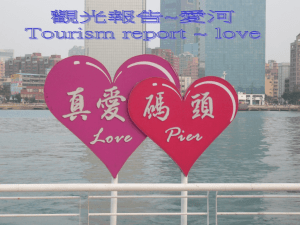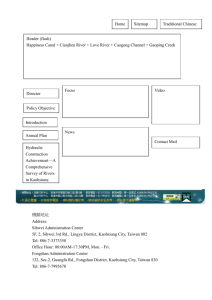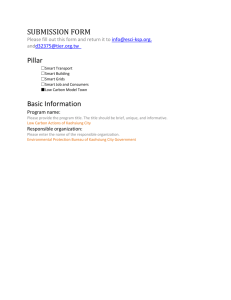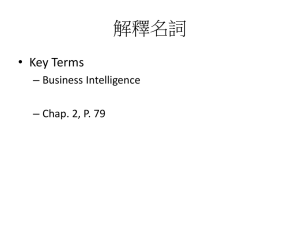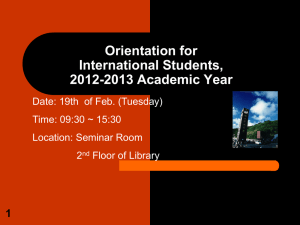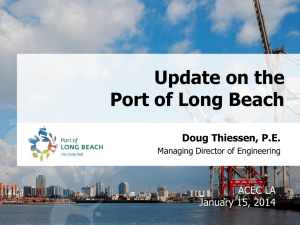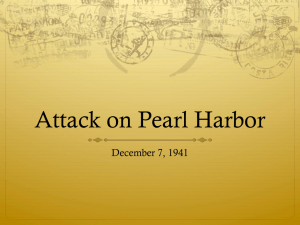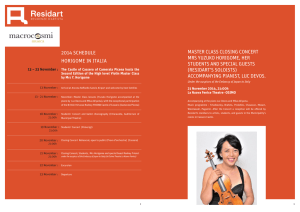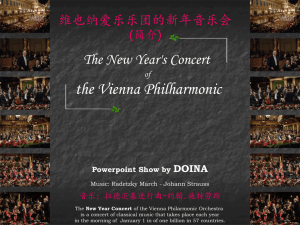Document
advertisement
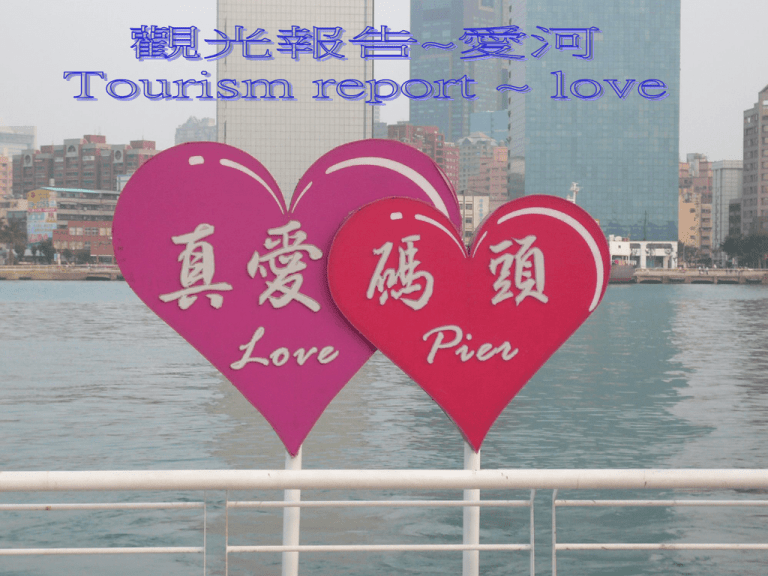
Number:3 Name:曾雋崴 囧 Number:11 Name:李連晟 0X0X0X0 Number:6 Name:王奕翔 王亦大羊羽 Member Number:27 Name:陳 徵 Number:37 Name:葉上裕 ㄜ…如圖 Number:1 Name:陳昭廷 DOMO Number:22 Name:張家慈 岡山人 Geography of Love River Love River , the lifeline of Kaohsiung City, originates from Ren-wu Township in Kaohsiung County, flowing through Zuo-ying, San-ming, Gu-shan, Yen-cheng, Chen-chi, Lingya and finally into the Kaohsiung Harbor. The main river is 12 kilometers in length. 10.5 km of the river flows through the essential sections of Kaohsiung City. The widest part of the river measures 130 m, and the narrowest 14 m. The origin of the Love River is a irrigation canal. The drainage area is about 5600 hectares. The population along the river is about 720,000 . The downstream of the Love River is divided into two courses flowing into the ocean. Right after the connection between the main river and the 2nd Canal, the river is divided into two . One flows into the Kaohsiung Harbor in Ling-ya-liao; the other used to flow into the sea in Hamashing, but later the silt turned the river into land. The main river used to be twice as wide as the current main river. The local people call the main river flowing through Yen-cheng District “Tao-cheng Harbor” (means the harbor in the front) Love River is unique in Taiwan. No one will think of Kaohsiung without thinking of Love River. It is a symbol of romance, but also plays an important role in the economic development. Compared with other rivers, Love River is short. It flows through the essential districts of Kaohsiung city and several important townships in Kaohsiung County. Different from other rivers, the Love River used to be a canal for transportation; nowadays, it is the main drainage canal and scenery spot. 愛河的地理 愛河是高雄市的生命線,起源於高雄縣仁武鄉,流經左營,三 民,岡山,鹽埕,前鎮,苓雅,其最終到高雄港。主要流域為 12公里。其中十點五 公里流經高雄市的精華區。河流最寬處為 13米 而最窄處為14米 愛河原為灌溉水渠。其排水面積約5600 公頃。沿河人口約七十二萬人。 下游的愛河分為兩個水道流入 大海。 其中一個水道在一處舊稱苓雅寮的地方流入高雄港, 而另一個則在 Hamashing流入大海 ,但後來淤泥把此河道變成 了土地。愛河原河流為目前河流的兩倍寬。當地人誇稱這條流 經鹽埕區“打狗港” (指港前)的河流在台灣是獨一無二的。 每個人一想到高雄就會想到高雄的愛河。這是一個象徵著愛情, 但也發揮了重要經濟作用的河流。相較於其他河流,愛河流域 是相當短的。但是 它流經高雄市的重要地區和高雄縣的幾個重 要鄉鎮。不同於其他河流的是愛河曾經是一條具有運輸功能的 運河;如今,它是具有排水功能的運河和著名的風景區。 The History of the Love River The Love River did not have a clear river course before Ming Dynasty. The main river and its branches combining with the sea around Kaohsiung Harbor formed a 150 square kilometers inland shallow sea. Later, because of the elevation of land and the silting up along the sea, the river course was formed. During Ching Dynasty, the Love river was simply called “Gang” (means “harbor” in Chinese). It was not until the beginning of Japanese colonization that the Love River was called “Da-gao River”. As the city name was turned from “Da-gao” to “Kaohsiung”, the Da-gao River was renamed Kaohsiung River. In 1908, when the railway from Keelong to Kaohsiung was completed, the Japanese government started a threephase harbor construction. This construction became the first renovation for the Love River by narrowing and deepening the river. This construction also enhanced the ability of transportation for wood. The Da-gao River became the Da-gao Canal. The History of the Love River After Taiwan was returned to the Republic of China, the government started to build parks along the river to attract tourists. In 1948, after one typhoon, part of the sign board of a boat rent shop read “Love River Boats for rent” was blown away, leaving only the two Chinese characters “Ai-ho” (means Love River”). When the reporters came to report a piece of news about lovers committing suicide by drowning themselves in the river, the sign board “Love River” was filmed and thus the name of “Love River” became popular. In 1968, the then Kaohsiung City mayor changed the name “Love River” to “Ren-ai River” to celebrate the birthday of the first lady. In 1992, some members of the Kaohsiung legislative body suggested the name “Ren-ai River” be changed back to “Love River”. In the 1960s, the rapid economic progress brought large population. The sewage system was not comprehensively built; therefore, most of the family waste water flew right into the river. The river’s selfcleaning ability was crashed, resulting in a dirty and smelly Love River. To make the matter worse, in the 1970s, several heavy industries in the Ten Major Economic Construction Projects were located in Kaohsiung, seriously polluting the Love River. No living marine life could be found in the river. Fortunately, in 1977, the government started to face the problem and built a complete sewage system. After years of renovation, the river comes into life again. The improved water quality and beautiful view along the river bring people back to the Love River. The Love River has become one of the most famous tourism spots in Kaohsiung. 愛河的歷史 在明朝時, 愛河沒有明確的河道。其主要河流及其分支河流結合高雄港附近海域形 成一個一五○平方公里的內陸淺海。後來,由於土地的隆起和海洋的淤塞,河道終於 形成。 在清朝,愛河只不過是所謂的“港” (意思是中文的“港口”) 。直到後來 日本殖民統治的時期 愛河被稱為“打狗河” 。隨著城市名字的改變,打狗河改名為 高雄河。於1908年,當時的高雄的鐵路已經完成,日本政府開始分三個階段興建港 口。這項工程成為第一個改造愛河的工程,縮小和深化河流。這項工程也提高了木材 的運輸。打狗河成為大運河。而後其回歸中華民國, 政府乃開始建設河流沿岸為公 園以吸引遊客。 1948年,一場颱風過後,部分“愛河船租鋪”的招牌被風吹走,只 留下兩個漢字“愛河” (指愛河。〉 “當記者一來到當地 報導一則愛侶自殺溺死自 己於此河流的新聞時,其招牌“愛河” 遂被拍攝下來 “愛河”成為流行。 1968年, 當時的高雄市長改“愛河改“為”仁愛河“ 以慶祝第一夫人的生日。 1992年,一些 高雄立法機關的成員建議將”仁愛河“改回”愛河“ 。在20世紀60年代,經濟的快 速進展引入大量人口。污水系統並沒有全面建立,因此,大多數的家庭廢水便流入河 中。河流的自淨能力於是被摧毀,造成又髒又臭的愛 河。而更糟糕的是,在70年代, 十大經濟建設的一些重工業項目都設在高雄,其嚴重污染了愛河。海洋生物在愛河失 去蹤影。幸運的是, 在1977年,政府開始處理這樣的問題,並建立一個完整的污水 處理系統。經過多年的整治。改善的水質和美麗的景色使沿河人民又重回愛河。愛河 已經成為高雄最有名的旅遊景點。 Sightseeing in the Love River 遊覽愛河 1. Love Pier A new covered resting area and outdoor arena was built east to the 3th Pier, the 11th pier and 12th pier for the public to enjoy beautiful sunset. The renovation of the old piers symbolizes the combination of the harbor and the city. 1 真愛碼頭 一種新的加蓋和室外休息場所 建於第3,第11和第12號碼頭 的東邊,供市民觀賞美麗的夕 陽。這翻新的舊碼頭象徵港口 和城市的 結合。 2. Heart of Love River Located on the intersection of Bo-ai Road and Tong-meng Road, the 1.7 billion cost in“Ru-Yi Lake, Heart of Love River ” is a project built on two artificial lakes. The Heart of Love River is built to extend upper stream to Ru-Yi Lake Dock. The east side of the lake is an eco-lake, offering the public a delightful resting area. 2 愛河之心 位置就在博愛路與同盟的交會處。 花費17億 成本建立的“如意湖,愛河之心”是一個計畫 以兩個人工湖為基礎。愛河之心的建立乃在延 長其上游到如意湖碼頭。湖的東邊是一個生態 湖,為市民提供一個愉快的休息區。 3.高雄歷史博物館 舊市政大樓乃建於1938年, 為日本統治 後期建物。其建築風格乃是所謂的“帝冠 風格” 。整個建築物看起來形似漢字 “高” (高雄的第一個字) ,象徵著高 雄市的精神。整修後,其古樸的建築風格 不變,但看起來更加明亮。高雄歷史博物 館已成為高雄的地標。 3. Kaohsiung Museum of History The old city government building was built in 1938 during later period of Japanese rule. The style of the building is so- called "imperial crown style". The whole building looks like the shape of the Chinese character “高” (the first character of city name:高雄Kaohsiung), symbolizing the spirit of Kaohsiung City. After renovation, the quaint style of the building remains intact but looks brighter. The Kaohsiung Museum of History has become the landmark of Kaohsiung. 4. Kaohsiung Concert Hall The Kaohsiung Concert Hall is established in November 2000, located behind the Kaohsiung Museum of History. The Concert Hall is well-equipped, with indoor concert halls and an outdoor concert plaza. The Kaohsiung Concert Hall has become a popular place for cultural activities. Currently, the Kaohsiung Concert Hall also houses the Kaohsiung City Chinese Orchestra and the Kaohsiung City Symphony Orchestra. Regular performances in the concert hall not only provide great opportunities for the talented musicians to hone their skills, but also offer the precious opportunities for the public to enjoy music. 4.高雄音樂廳 高雄音樂廳成立於2000年11月,位於高雄歷史 博物館後面。音樂廳裝備精良,配有室內音樂會 和露天音樂會廣場。高雄音樂廳已成為一個受歡 迎 的地方文化活動中心。目前,高雄音樂廳還 設有高雄市國樂團及高雄市交響樂團。經常演出 的音樂廳不僅提供了很棒的機會給有天分的音樂 家們磨練他們的技能,而且還提供珍貴的機 會 以讓市民欣賞音樂。 5. 在馬背上的愛河警察 愛河警察在馬背上推出了他們的“夏季活動,註銷太陽”活動,其乃一系列的大 型戶外演出和活動,如音樂會,帆船比賽,衝浪競爭等等。舉辦這些活動,以促進 高雄的 旅遊業。然而,大批的遊客可能會導致公眾安全的問題。 愛河馬背上的 警察形成改變斯特恩的警察形象。此外,他們還補充了普通警察部 隊與巡邏警車的缺乏,在馬背上的警察可以很容易地繞過擁擠的領域和更 有效地 處理緊急情況。除了維持交通暢順,馬背上的 警 察也可以去各地城市遭受忽視的 危險彎道維護公共安全或深達難以接觸到的地形以維護治安。 此外,除了在馬背上的警察,也有在自行車上的警察。他們的任務是維護高雄三 個主要單車徑系統的 安全。自行車警察還有助於減少使用礦物燃料和保持環境清 潔。自行車警察招募來自不同派出所員警,誰負責愛河的自行車必須駐紮在幾個風 景區周圍城在市週末和節假日以讓遊客安全。 suggestions First of all, after renovation, the riverbank along the Love River has become a popular place for leisure, including both pedestrians and cyclists. However, the paths on both sides of the river are not wide enough to accommodate the walking crowds and racing cyclists. Besides, the paths are not slippery-proof, which poses some threat to the users. In the future, the government should improve the quality of the cycling path and modify the course so that both pedestrians and cyclists can enjoy a safe leisure environment. Secondly, the value of land in Kaohsiung is soaring with the help of the High Speed Rail, the Dream Mall, the Kaohsiung Arena, and the completion of the Red Line of the Kaohsiung Mass Rapid Transit system, and the project of the International Pop Music Center. Moreover, the real estate surrounding the Love River area is soaring, following the successful renovation of the Love River and several other new constructions, such as the Shinguang Pier and the Kaohsiung Film Archive. However, the real profits go not to the old houses by the river, but to the new high-rise buildings which have a good view of the Love River and the Urban City Light. Therefore, the government should try to promote the old houses by the Love River by improving the housing policy and landscaping. Nowadays, business can not work alone. To boost prosperity, shops and business districts should work together to enhance their overall competitiveness by efficient marketing, enhancing the advantages of the shopping district, creating a trusting image and a pleasant environment. After renovation, the Love River has help boost tourism not only in the Love River area, but also other areas in Kaohsiung. The inhabitants living by the river play an important role in the future development of the Love River. They will also change the structure of business in this area. 建議 首先,經過整治,愛河沿岸已成為一個受歡迎的休閒場所,包括行人和騎自行車者。但 是,河兩邊的道路不寬,不足以容納步行的人群及賽車或騎自行車者。此 外,道路不 能防滑,已證實會帶來了一些威脅到用戶。今後,政府應圖謀改善,使行人和騎自行車 者都可以享受一個安全的休閒環境。 其次,土地的價值是在高雄環境的改善中飆升,例如:高速鐵路、 夢時代 、高雄市體 育場、高雄捷運系統紅線的完成及國際流行音樂中心的計畫。此外,愛河周邊地區的房 地產飆升後,成功地改造愛河和其他一些新的建築,如新光碼頭與高雄電影資料館。然 而,真正的利潤不是在河流邊的老房子,而是新的高層建築有一個很好的景觀,。因此, 政府應努力促進愛河老房子的改善和環境美化。 如今,企業不能單獨工作。為了促進繁榮,商店和商業區應共同努力,提高他們的整體 競爭力及具有高效率的經營,提高優勢的購物區,建立一個可信賴的形象和優美舒適的 環境。 整治後的愛河可以促進旅遊業不僅在愛河地區,其他地區亦然。愛河不但影響沿岸居民 的生活。他們也將改變這一領域中的企業結構。 MAP
